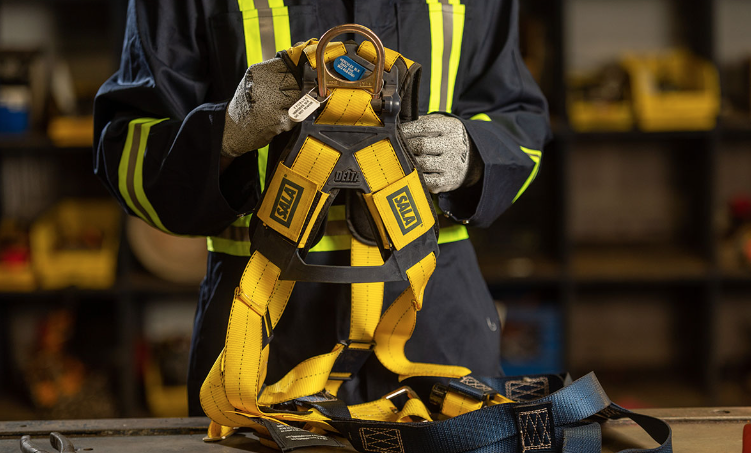EQUIPMENT INSPECTION
Wearing fall arrest equipment without inspecting it provides a false sense of security. This equipment is
subject to tremendous loads during a fall, so unless each component is thoroughly inspected and properly
used, it may not save your life. Always follow the manufacturers’ recommendations when inspecting your
equipment.
FULL BODY HARNESS & POSITIONING BELTS
• Thoroughly inspect all nylon webbing for frayed edges, broken fibers, burn marks, deterioration, or other damage
• Do the same if the harness is constructed of other materials
• Stitching should be intact and not torn or loose
• The harness should be somewhat soft and flexible and not stiff from dirt or contaminants
• Check to see that buckles and D-rings are not distorted or damaged
• Look closely at all components for stress cracks, deformity, gouging, corrosion, and sharp edges
• Inspect connection points where the buckle or D-ring is attached to the belt or body harness
• Ensure that no stitching is pulled and that the buckle or D-rings is securely attached
• Inspect all rivets and grommets to be certain they are not deformed and are securely fastened and cannot be pulled loose
If you find any faulty conditions during the inspection, do not use the equipment.
LANYARDS & SELF-RETRACTING LANYARD (SRL)
• Completely check the entire length of the lanyard looking for cuts, fraying, deterioration, knots, kinks, burns, or visible
signs of damage; stitching should be intact and not torn or loose
• Connector ends must also be carefully examined for damage or deterioration.
• Check to see that the lanyard is somewhat soft and not stiff from dirt or contaminants
• If using a shock absorber type of lanyard, look for the warning tag that indicates if the lanyard has been exposed to a fall
• Snap hooks and eyes should not be distorted or bent; inspect them for cracks, sharp edges, gouges, or corrosion
• The keeper / latch should seat into the nose without binding and should not be distorted or obstructed
• The keeper spring should exert sufficient force to firmly close the keeper; keeper locks must prevent the keeper from
opening when the keeper closes
• If using a SRL, inspect the body of the mechanism for flaws to assure that all nuts, screws, and rivets are installed and
tight; also check crimped ends or stitching for damage
• Inspect the entire length of the SRL for any visible signs of defects; check to be sure the locking mechanism is operating properly and that there is no binding
• Test the locking mechanism by pulling sharply on the cable end to be sure it locks immediately and firmly
• SRLs must be annually audited by a competent person and marked accordingly
Diligence = Success. Inspect all fall protection devices and anchor points prior to each use! Removed damaged fall protection
equipment of service immediately, new equipment will be provided.
Personal fall arrest systems are one way to protect workers on construction sites where there are vertical drops of six or more
feet. Systems must be set up so that a worker cannot fall more than six feet, nor come into contact with any lower level. You
should be able to answer YES to each of the following:
• Is your Personal fall arrest system made up of an anchorage, connecting device, and a full-body harness?
• Are the components from the same manufacturer to ensure that the system works as it should?
— If not, has any substitution or change to a personal fall arrest system been fully evaluated or tested by a competent
person to determine that it meets the standard?
• Has your personal fall arrest system been inspected for damage each time before you wear it?
— If there are defects, or if someone has taken a fall using the equipment, it must be removed from service.
• Is the attachment location of the body harness in the center of your back, near the shoulder level, or above your head?
• Do vertical lifelines or lanyards have a minimum breaking strength of 5,000 lbs?
— Are they protected against being cut or abraded?
• Will each worker be attached to a separate vertical lifeline?
• Is the webbing made of synthetic fibers?
• Is the anchorage independent of any anchorage used to support or suspend platforms? Is it able to support at least 5,000 lbs per worker attached to it?
• Are the connectors made from steel or equivalent materials, with a corrosion-resistant finish and smooth edges?
• Do the D-rings and snaphooks have a minimum tensile strength of 5,000 lbs?
• Are snaphooks of a locking-type and designed to prevent the snaphook from opening and slipping off the connector?
• Are the snaphooks not directly connected to the webbing, rope or wire, to each other, to a D- ring to which another
snaphook or other connector is attached, to a horizontal lifeline, or to any other object that could cause the snaphook to
open?


